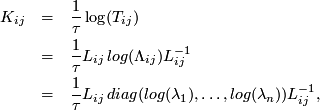You are here: Foswiki>CompMolBio Web>AGCompMolBio>TransitionMatrixSampling>TransitionMatrix (29 Oct 2007, StefanBernhard)Edit Attach
Transition Matrix
Properties
Transition matrices are so called stochastic matrices, which means, that all entries are real values between zero and one, meaning, that each entry is a probability and a row sum equal one, meaning that the probability to jump to an arbitrary state is one- there exists a positive eigenvalue of one, which is called Perron Eigenvalue
- All other eigenvalues lie within the spectral radius defined by the Perron Eigenvalue
![\[|\lambda_{i}|\le1=|\lambda_{Perron}|\]](/wiki/pub/CompMolBio/TransitionMatrix/latex76078ab5c002a6ca8f5b5a1bb4cf644e.png)
- the associated left and right eigenvector are also non-negative, so also the left eigenvalue is non negativ.
- if all entries
 are strictly positive, then, the dimension of the eigenspace associated with the Perron-Eigenvalue is one.
are strictly positive, then, the dimension of the eigenspace associated with the Perron-Eigenvalue is one.

Edit | Attach | Print version | History: r3 < r2 < r1 | Backlinks | View wiki text | Edit wiki text | More topic actions
Topic revision: r2 - 29 Oct 2007, StefanBernhard
 Copyright © by the contributing authors. All material on this collaboration platform is the property of the contributing authors.
Copyright © by the contributing authors. All material on this collaboration platform is the property of the contributing authors. Ideas, requests, problems regarding Foswiki? Send feedback
